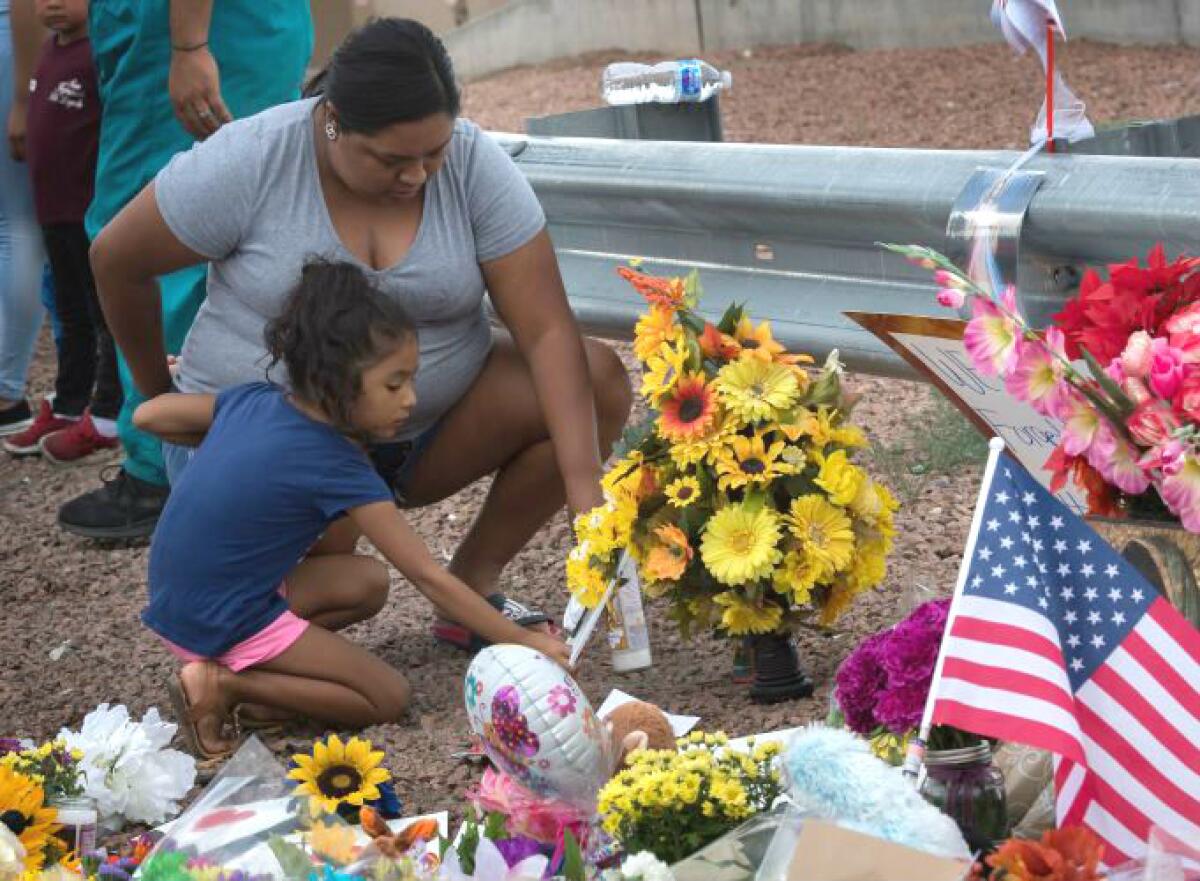Editorial: As the El Paso massacre showed once again, white supremacy is the poison in our well

- Share via
Most people know that racism and white supremacy have been part of America since even before we became a nation. There’s no need to recount the slavery system on which this country’s early wealth was built, from Southern plantations to New England-owned slave ships to the rise of Wall Street banks that financed both the cotton and slave trades. Most of us also know about the Jim Crow system, the bouts of xenophobia, the rise of the Ku Klux Klan and the internment of Japanese American citizens during World War II.
What’s less well understood is the undeniable through-line to today’s racial disparities in wealth and health and lifespan and other measures of well-being. That cannot be wished away or compartmentalized any more than the outbreaks of racial antagonism that occur far too often. Against that background, the current resurfacing of white supremacist ideologies is both shocking and predictable. Add in guns, and well, suddenly we have dead bodies in El Paso, in Gilroy, in Poway and Pittsburgh and Charleston and too many other places to list.
White nationalism, or whatever you want to call it, is a serious and growing reality. Violence by white men who have been inspired by extremist ideologies make up an increasing share of domestic terror cases, the FBI says. According to the Anti-Defamation League, 73.3% of all extremist-related fatalities in the past decade in the U.S can be linked to right-wing extremists (compared with 23.4% that can be attributed to Islamic extremists). Earlier this year, FBI Director Christopher Wray described white supremacy and other forms of domestic extremism as a “persistent, pervasive threat.”
So President Trump was right on Monday to declare that “hate has no place in America.” He also said that “in one voice, our nation must condemn racism, bigotry, and white supremacy.” But the president should start with himself. He has called Mexicans and other immigrants “thugs” and “animals” who are invading the U.S., disparaged much of the Third World as “shithole countries,” characterized some of those supporting a neo-Nazi rally in Virginia that turned fatal as “very fine people,” and just recently described sections of Baltimore as so blighted that “no human being would want to live there.” Those kinds of nasty and divisive statements help create a climate and culture in which racist extremism can thrive.
Meanwhile, as The Times’ Molly O’Toole reported Monday, the Trump administration has redirected millions in federal funds from programs targeting domestic terrorism to programs designed to counter Islamic extremists. That’s a misallocation of resources.
The vast majority of the mass killings in this country, and our daily barrage of single and double homicides, have causes other than racist ideology, ranging from mental illness to domestic violence to workplace meltdowns. But violence committed in the name of racism — or misogyny, anti-Semitism, homophobia and the like — carries a peculiarly troubling weight.
The recent rash of extremist violence did not begin with Trump. During the Obama administration, Dylann Roof killed nine black worshipers at a Charleston, S.C., church in hopes of stoking a race war. George W. Bush was president when Douglas Williams, described as a racist by coworkers, shot up a diversity training session at a Lockheed Martin plant in Meridian, Miss., killing six people before turning the gun on himself. And white nationalist movements — and violence — have increased in other parts of the world, as well. The white Australian gunman in Christchurch, New Zealand, targeted Muslim immigrants. Political parties in Italy, Austria and Germany have been infused by often racially tinged anti-immigrant beliefs.
So what do we do about it? That’s the thorny question, since our collective actions must be against not just the crimes — murder and assault — but also against the thought and theory that underlie them. For the crimes, we have a system that handles them after the fact and government programs to try to ferret them out before thought becomes deed. But the Constitution rightly requires the government to give free rein to political expression. That right to free speech is one of the nation’s most enduring freedoms, and embracing it means allowing speech that the vast majority of us find utterly repellent. We can’t, and shouldn’t, stifle such speech, be it from a soapbox or a site living in the darker recesses of the internet. But we must counter it.
Of course, such vile beliefs wouldn’t be so deadly here in the U.S. without easy access to firearms. In that regard, our 1st and 2nd amendments both offer extremists tools they can use in their efforts to kill people they perceive as enemies.
We must fight their hate-based ideologies, remembering that this is not a “white nation” or a “white culture.” We have from the beginning been an experiment in the mingling of races and ethnicities, of religious creeds and political visions. That is where our future also must lie — in the protective and tolerant embrace of our differences, not in the violent expression of fear and prejudice.
More to Read
A cure for the common opinion
Get thought-provoking perspectives with our weekly newsletter.
You may occasionally receive promotional content from the Los Angeles Times.










